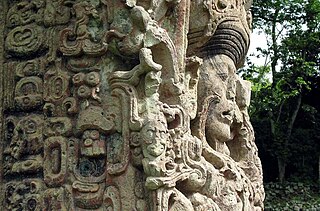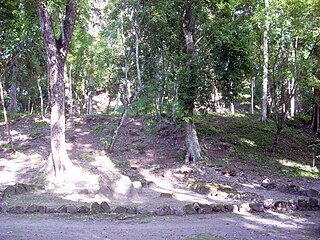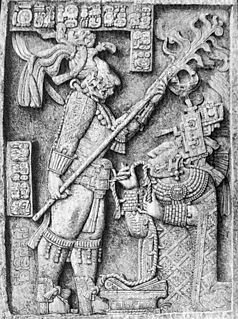The 32nd century BC was a century which lasted from the year 3200 BC to 3101 BC.

Sak Kʼukʼ also known as Muwaan Mat, Lady Sak Kʼukʼ and Lady Beastie, was queen of the Maya city-state of Palenque. She acceded to the throne in October, 612 and ruled until 615.
A baktun is 20 katun cycles of the ancient Maya Long Count Calendar. It contains 144,000 days, equal to 394.26 tropical years. The Classic period of Maya civilization occurred during the 8th and 9th baktuns of the current calendrical cycle. The current baktun started on 13.0.0.0.0 — December 21, 2012 using the GMT correlation.

Linda Schele was an expert in the field of Maya epigraphy and iconography. She played an invaluable role in the decipherment of much of the Maya hieroglyphs. She produced a massive volume of drawings of stelae and inscriptions, which, following her wishes, are free for use to scholars. In 1978, she founded the annual Maya Meetings at The University of Texas at Austin. She was from Hendersonville, TN, a northern suburb of Nashville. Her mother Ruby Richmond was active in historic preservation at Historic Rock Castle in the 1980s.

Kukulkan is the name of a Mesoamerican serpent deity. Prior to the Spanish Conquest of the Yucatán, Kukulkan was worshipped by the Yucatec Maya peoples of the Yucatán Peninsula, in what is now Mexico. The depiction of the Feathered Serpent is present in other cultures of Mesoamerica. Kukulkan is closely related to the deity Qʼuqʼumatz of the Kʼicheʼ people and to Quetzalcoatl of Aztec mythology. Little is known of the mythology of this Pre-Columbian era deity.

Uaxaclajuun Ubʼaah Kʼawiil, was the 13th ajaw or ruler of the powerful Maya polity associated with the site of Copán in modern Honduras. He ruled from January 2, 695, to May 3, 738.
David Humiston Kelley was an American archaeologist and epigrapher, of the University of Nebraska-Lincoln, and later of the University of Alberta in Calgary, most noted for his work on the phonetic analysis and major contributions toward the decipherment of the writing system used by the Maya civilization of pre-Columbian Mesoamerica, the Maya script.
Putún or Chontal Maya is a collective name for several groups of Maya that displaced much of the older leadership of the Maya Lowlands during the Late Classic and Postclassic. The Putún, who came from the Gulf coast in the northwest region of the Maya area, are generally held to have been more Mexicanized than their contemporaries. They were associated with the Puuc architectural style and distinctive orangeware pottery. The Itza are often considered a group of Putún Maya. The contemporary Chontal Maya of Tabasco speak a closely related language.

Tortuguero is an archaeological site in southernmost Tabasco, Mexico which supported a Maya city during the Classic period. The site is noteworthy for its use of the B'aakal emblem glyph also found as the primary title at Palenque. The site has been heavily damaged by looting and modern development; in the 1960s, a cement factory was built directly on top of the site.

Ixlu is a small Maya archaeological site that dates to the Classic and Postclassic Periods. It is located on the isthmus between the Petén Itzá and Salpetén lakes, in the northern Petén Department of Guatemala. The site was an important port with access to Lake Petén Itzá via the Ixlu River. The site has been identified as Saklamakhal, also spelt Saclemacal, a capital of the Kowoj Maya.

The Mesoamerican Long Count calendar is a non-repeating, vigesimal (base-20) and base-18 calendar used by several pre-Columbian Mesoamerican cultures, most notably the Maya. For this reason, it is often known as the MayaLong Count calendar. Using a modified vigesimal tally, the Long Count calendar identifies a day by counting the number of days passed since a mythical creation date that corresponds to August 11, 3114 BCE in the Proleptic Gregorian calendar. The Long Count calendar was widely used on monuments.

Itzamnaaj Bʼalam II was a Maya king who ruled in Yaxchilan from 681 until he died in the year 742. He is also called Shield Jaguar II by modern writers and commonly referred to simply as Shield Jaguar based on his name glyph before the phonetic name was deciphered.
Rulers of Yaxchilan were leaders of the Maya civilization polity of Yaxchilan during its existence as a prominent city-state. The first high king (ahau) was Yat Balam in the year 320. The dynasty probably ended in the late 9th century with the decline of Yaxchilan. The greatest of the high kings were Itzamnaaj B'alam II and his son Yaxun B'alam IV.

Chak Tok Ichʼaak I also known as Great Paw, Great Jaguar Paw, and Toh Chak Ichʼak was an ajaw of the Maya city of Tikal. He took the throne on August 7, 360? and reigned until his death in 378, apparently at the hands of invaders from central Mexico.

Yax Nuun Ahiin II also known as Ruler C and Chitam,, was an ajaw of the Maya city of Tikal. He took the throne on December 25, 768 and reigning probably until his death. He was son of Yik'in Chan K'awiil and brother of 28th Ruler. The monuments associated with Yax Nuun Ahiin II are: Stelae 19, 21 and Altars 6 and 10.

During the 7th and 8th centuries in Mesoamerica, there was an evident shift in the roles women played in ancient Maya society as compared with the previous two centuries. It was during this time that there was a great deal of political complexity seen both in Maya royal houses as well as in the Maya area. Warfare was a significant factor in political competition and marriage was one of the ways that alliances were made between the different polities. This was accompanied by a shift in women's roles from wife and mother to playing integral parts in courtly life, such as participating in rituals involving the supernatural world and at times ruling individual polities.

The 2012 phenomenon was a range of eschatological beliefs that cataclysmic or otherwise transformative events would occur on or around 21 December 2012. This date was regarded as the end-date of a 5,126-year-long cycle in the Mesoamerican Long Count calendar, and as such, festivities to commemorate the date took place on 21 December 2012 in the countries that were part of the Maya civilization, with main events at Chichén Itzá in Mexico, and Tikal in Guatemala.

Nikolai Grube is a German epigrapher. He was born in Bonn in 1962. Grube entered the University of Hamburg in 1982 and graduated in 1985. His doctoral thesis was published at the same university in 1990. After he received his doctorate, Grube moved to the University of Bonn. Nikolai Grube has been heavily involved in the decipherment of the Maya hieroglyphic script.

Kʼinich Muwaan Jol, was ajaw of the Maya city-state of Tikal. He was father of Chak Tok Ichʼaak I and he ruled until 359.














